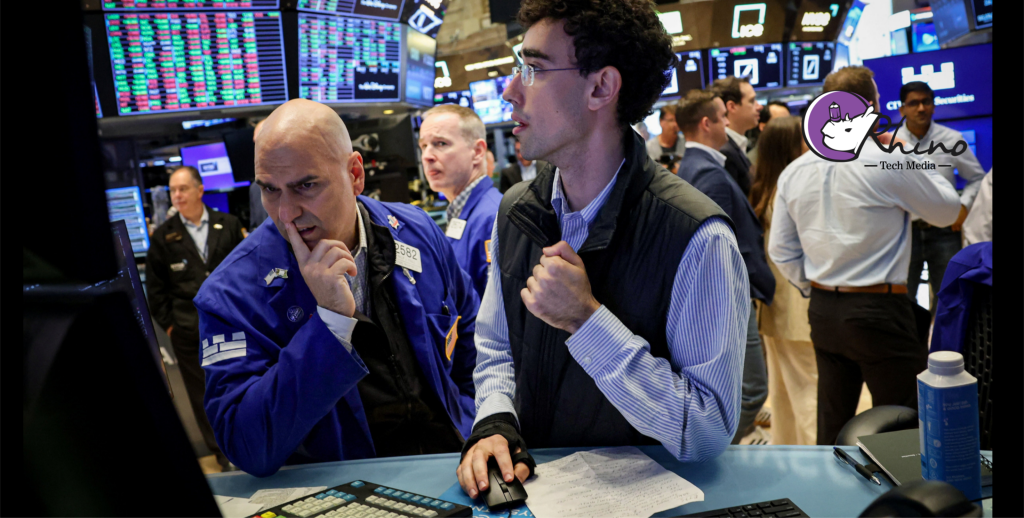Wall Street Today: US Stocks Edge Higher on Fed Rate Cut Hopes
Over the past several trading sessions, optimism has steadily built in US financial markets around the expectation that the Federal Reserve will begin easing policy by lowering interest rates — the first cut anticipated in some time. This expectation is shaping investor behaviour, underpinning modest gains in major indices, even as markets keep one eye on potential risks and upcoming macro data.
1. Market Performance and Investor Sentiment
US equity markets opened with cautious optimism. The S&P 500, the Dow Jones Industrial Average, and the Nasdaq Composite all ticked upward — each by small margins — driven by strong retail sales data for August and growing confidence that the Fed will make a 25 basis point cut in interest rates at the conclusion of its two-day meeting.
However, these gains have been tempered by caution. Earlier in the day, both the S&P and Nasdaq had touched record highs before easing back slightly. Investors are particularly focused on how the Fed will not only cut rates, but also communicate its outlook for future policy steps.
2. Economic Backdrop: Retail Sales, Labor Market, Inflation
One of the key supports for market optimism has been unexpectedly strong retail sales in August. Retail spending rose about 0.6% month-over-month, significantly above economists’ estimates of around 0.2-0.3%. This suggests that consumer demand remains resilient even in the face of cost pressures. The strength in retail helps counterbalance concerns about a slowing labor market, which many believe is weakening.
Inflation remains a concern, but cooler inflation or expectations of easing inflation are part of why rate-cut expectations are gaining traction. Meanwhile, labor market signals are mixed: hiring slowdowns and other soft indicators have raised concern among policymakers that maintaining current rates for too long may impair growth.
3. Fed Meeting and Rate Cut Expectations
A focal point is the Federal Reserve’s two-day meeting, which begins today and concludes tomorrow. Most market watchers expect the Fed to cut its benchmark interest rate by 25 basis points. There is also considerable attention on how the Fed will frame its forward guidance — in particular, how many cuts it foresees this year, and under what conditions.
Despite strong retail data, the market is wary: strong spending could imply persistent inflation, which the Fed would be reluctant to let run ahead. Thus, while a cut is largely baked into expectations, the degree of dovishness in the Fed’s projections and statements will likely drive volatility.
4. Sectoral Highlights and Stock-Specific Moves
Some sectors are showing differentiated performance:
- Financials and regional banks have underperformed, in part due to concerns about margin pressure and uncertainty over how lower rates could affect lending spreads.
- Energy stocks got a boost amid rising oil prices.
- Technology / Discretionary sectors are benefiting from optimism around policy easing and strong growth narratives. For example, Oracle’s shares have jumped on reports related to a potential framework deal involving TikTok, which might help the software company deepen its involvement with cloud services.
On the flip side, some individual stocks are under pressure. Warner Bros. Discovery, for instance, dropped significantly after a downgrade. Others like Dave & Buster’s saw steep declines following weak earnings signals.
5. Risks and What to Watch
While optimism is high, several risks could unsettle current market sentiment:
- Fed’s messaging: If the Fed signals less willingness to follow up a rate cut with additional easing, or emphasizes inflation risks, markets could pull back.
- Labor market surprises: Although some softening is expected, stronger-than-anticipated labor data could prompt the Fed to hold rates higher for longer.
- Inflation persistence: If inflation metrics (or other price pressure indicators) remain sticky, that could complicate the Fed’s mandate and market expectations.
- Geopolitical or trade risks: As with past months, trade developments, regulatory news, or tensions (e.g. US-China) remain tail risks.
6. Outlook and Market Implications
Assuming the Fed does follow through with a 25 basis-point rate cut, and the forward guidance is moderately dovish, markets may see further upside. Key indices could push new highs, particularly if consumer demand and spending stay resilient.
However, return expectations should be tempered: sharp gains are less likely unless the Fed signals a path toward more cuts or unless economic data begins to paint a picture of a gentle slowdown rather than a hard landing. Volatility around the Fed meeting is probable.
For investors, sectors that tend to benefit from easing (like consumer discretionary, certain tech names, utilities) might outperform, while financials may lag unless yield curves steepen or lending conditions improve.
Conclusion
In sum, Wall Street is currently in a state of cautious optimism. Rate cut hopes are fuelling equity gains and a holding near record levels, even as economic data — especially strong retail sales — suggests some underlying resilience in the US economy. The upcoming Fed meeting is acting as the pivot point: it is not just whether rates will be cut, but how and what message will accompany that action. The outcome of the meeting, and subsequent guidance, will likely set the tone for markets in the near term.

